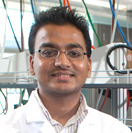A native of sun-drenched southern India, where daily high temperatures often exceed 100 degrees, discovers that one of the best places to pursue his interest in solar energy is an upstate New York community noted for its cloud cover.
“Since childhood, I have been interested in energy sources that are nonpolluting and are abundant,” says Siva P. Adusumilli, who received his bachelor’s degree in electrical and electronics engineering from Jawaharlal Nehru Technological University. “I did some homework, and I found out about Binghamton University’s Center for Autonomous Solar Power.”
Now Adusumilli is a doctoral student at Binghamton while working as a graduate research associate at the center known as CASP. His focus is on earth-abundant solar materials and nanomaterials.
Some substances, such as silicon, are well-suited for use in solar cells but are costly to process and, therefore, drive up the price of the end product. That limits the cells’ potential for wide usage even though the energy source — the sun — is free, Adusumilli says. He also points out the illogic of having to use great quantities of energy to synthesize materials to be used in products designed to produce or save energy. Research in earth-abundant materials, which are relatively much cheaper, is a growing field.
Adusumilli’s work has been in the synthesis of two such substances for use in thin-film solar cells: iron pyrite (aka “fool’s gold”) and zinc phosphide. Charles R. Westgate, director of CASP, says Adusumilli has won numerous student poster contests and drawn attention from colleagues at prestigious universities for his findings. “He has been successful in achieving high-quality films and nanomaterials like carbon nanotubes and is now optimizing their growth for solar cells,” Westgate says.
Unless the price of raw materials drops, solar energy will not be an appealing option for homeowners, Adusumilli says. “When people put in a solar roof, they think, ‘How long is the payback?’ and, if it’s 20 years …” he says, trailing off with a knowing shrug.
Much of CASP’s funding comes from government agencies, but the center “tries to have communication with industry. Companies like IBM and GE — they know what is needed,” says Adusumilli, who sees himself as a research scientist with a U.S. company after graduation. “Since my childhood, I’ve had the image of me in a research lab coat.”








